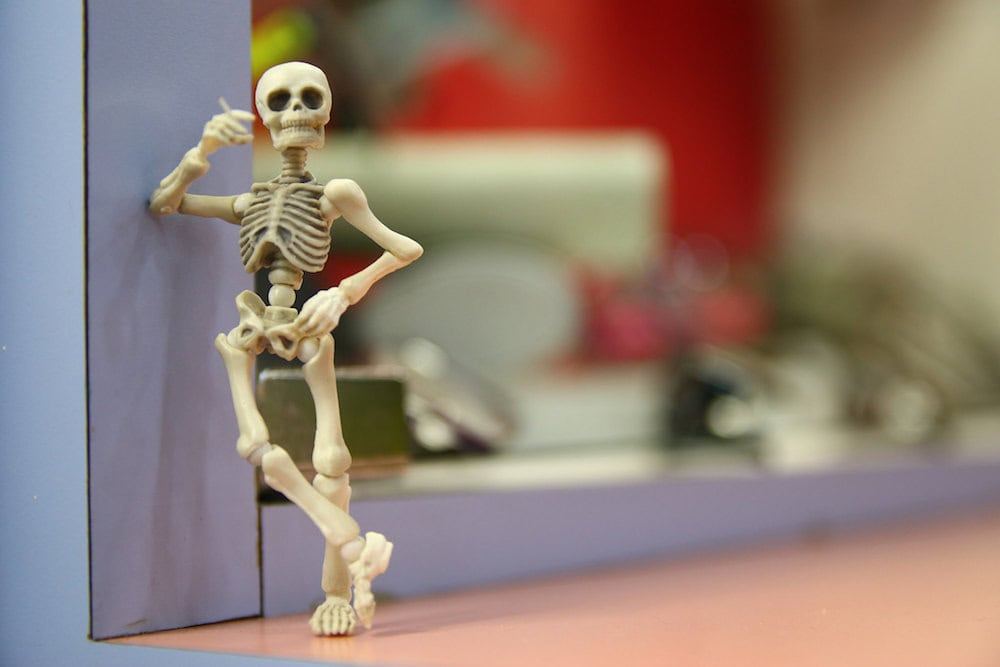
[Image above] Credit: JUN 4 1 4; Flickr CC BY-ND 2.0
Bioactive glass is a beautiful thing. And it can look delicious, too.
While it may only resemble cotton candy in appearance, however, that doesn’t make bioactive glass, or bioglass, any less impressive. As if glass wasn’t already an amazing material, bioglass is a biomaterial, meaning that it interacts with the human body to repair or replace tissues.
Larry Hench discovered the original 45S5 bioglass formulation back in 1969, and it has now found its way into millions of patients, helping fix bone and dental defects all around the world. Since discovery, bioglass has evolved in composition and capabilities—from simple silica-based compositions to heal hard tissues like bone to borate-based fibers that can support soft tissue repair, too.
More recently, bioglass has been used to heal large bone defects, protect sensitive teeth, repair cartilage, plus more. And, based on new research, you may soon be able to add treating bone infections to its roster of accomplishments.
An international, interdisciplinary research collaboration led by Fergal O’Brien, professor of bioengineering and regenerative medicine at the Royal College of Surgeons in Ireland, and including co-investigator Aldo Boccaccini, ACerS Fellow and head of the Institute of Biomaterials at the University of Erlangen-Nuremberg in Germany, developed a multifunctional bioglass scaffold that can simultaneously prevent infection, stimulate bone repair, and prompt the body to heal supportive tissues—all without added antibiotics nor growth factors.
While this new bioglass could help treat multiple bone-based medical problems, it looks particularly promising for treating osteomyelitis.

Emily Ryan, the study’s first author and a Ph.D. student in the RCSI Department of Anatomy, and Fergal O’Brien aided in the development of a new bioglass scaffold that could help treat multiple bone-based medical problems. Credit: RCSI
Osteomyelitis is a difficult-to-treat bone infection usually caused by a bacteria called Staphylococcus aureus—the same bug of MRSA (methicillin-resistant Staphylococcus aureus) antibiotic resistance fame. While relatively rare, osteomyelitis is a big clinical problem simply because it is not easy to treat, especially when cases are chronic and severe. When cases turn severe, osteomyelitis treatment gets ugly—we’re talking heavy-duty antibiotics pumped into a patient’s bloodstream, surgery to scrape out dead bone tissue, and bone grafting procedures to attempt to heal the diseased bone. Ouch.
And if that wasn’t enough, these grueling treatments for osteomyelitis fail 20–30 percent of the time. This is why the new all-in-one bioglass strategy could be the clinical trifecta when it comes to bone healing.
The bioglass scaffold’s secret weapon is that the bioglass is doped with 2 percent copper, an element that’s inherently antibacterial. Copper kills bacteria (and other microbes) by disrupting their outer membranes.
“Copper-doped bioglasses are being increasingly considered in several tissue engineering approaches, both for bone and soft tissues,” Boccaccini says in an email. “One novelty is the exploitation of the release of [copper] ions to promote angiogenesis, without using (rather expensive) growth factors.”
While new bone growth is an obvious component of repair, the ability to grow new blood vessels, called angiogenesis, is another critical component. Without adequate blood supply, new tissue will eventually die, lacking the oxygen and nutrients supplied by blood.
The research team used a sol-gel method to fabricate their copper-doped bioglass, composed of 60 percent silicon dioxide (SiO2), 34 percent calcium oxide (CaO), 4 percent phosphorous pentoxide (P2O5), and 2 percent copper oxide (CuO). Then they ground up the bioglass and integrated it into a collagen scaffold for structural support. According to Boccaccini, this combination of bioglass in particulate form with a collagen scaffold is a particular novelty of their bioglass.
In regard to scaffold strength, Boccaccini says the bioglass actually makes the collagen scaffold better. “Incorporation of bioglass particles has improved the mechanical properties to levels seen in previous collagen–hydroxyapatite scaffolds, which the O’Brien lab at Royal College of Surgeons in Ireland have successfully tested in rats, mice, rabbits, goats, horses and, most importantly, in almost 50 human patients,” he explains in the email.
In cell culture experiments, the team’s scaffolds released copper ions and killed up to 66 percent of bacteria. Importantly, the copper ions were not toxic to human cells. The scaffolds also indicated increased ability to form new bone and blood vessels, although there were eventually some inhibitory effects over longer time periods in cell culture.
However, cell culture experiments aren’t entirely reliable—after all, cell culture is a model system that doesn’t perfectly replicate what would happen in an actual living organism. So, the researchers took their experiments to the next step—they also tested how their bioglass scaffolds performed in chick embryos grown in the lab, out of their shells (called an “ex ovo” model).
The chick experiments showed that the scaffolds enhanced both bone growth and vessel growth. Taken together, these results are signs that the bioglass can help heal and support new bone tissue, both critical components for long-term bone repair.
Ultimately, an all-in-one material solution that can prevent infection, heal bone, and stimulate growth of new blood supply is a promising possibility, and one that opens up additional possibilities as well.
“This platform system could be further modified and used to deliver a variety of other non-antibiotic antimicrobial metal ion-doped minerals,” O’Brien says in an RCSI press release.
What are next steps for the researchers? “The next obvious study would be to test the biomaterials in an infected bone defect model,” Boccaccini says. “Based on the special properties of the collagen-bioactive glass combination, there is also interest in expanding the application of the technology to soft tissue applications, including wound healing.”
The paper, published in Biomaterials, is “Collagen scaffolds functionalised with copper-eluting bioactive glass reduce infection and enhance osteogenesis and angiogenesis both in vitro and in vivo” (DOI: 10.1016/j.biomaterials.2019.01.031).
Author
April Gocha
CTT Categories
- Biomaterials & Medical
- Glass


